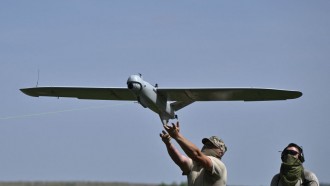The asteroid that NASA's DART mission successfully hit last year, Dimorphos, has been discovered by researchers to be behaving erratically in space, with the team noticing a change in its orbit. The main goal of the Double Asteroid Redirection Test (DART) was to determine if hitting asteroids with a spacecraft would change its course to avoid the planet and deal grave damage.
It also looked into developing a new method of diverting asteroids from their collision course towards the Earth, thereby having a new frontline to protect the home planet.
Dimorphos, the Asteroid which NASA's DART Hit is Behaving Erratically
(Photo : ASI/NASA via LICIACube on Twitter)
New Scientist released a report about the latest discoveries on Dimorphos, an asteroid that researchers have been tracking after it was hit by a NASA CubeSat under the DART mission last year. This came from the recent study from the Thacher School in California, led by Jonathan Swift who shared the details of their findings.
According to the researchers, "The number we got was slightly larger, a change of 34 minutes," says Swift. "That was inconsistent at an uncomfortable level."
It saw that Dimorphos' orbit shrank since it was hit by NASA's DART, with the findings giving NASA and other space agencies the information about what hitting an asteroid would do to its orbit and course.
Read Also: NASA DART Collision Aftermath: 2 Million Pounds of Debris Boosts Momentum Exchange!
NASA's DART Mission: Is It a Success?
The Sun US relayed word from Nancy Chabot, coordination Lead on DART at Johns Hopkins Applied Physics Laboratory, who claimed that the DART team would also publish its findings soon.
As per Chabot, "It's really good to know what we did to Dimorphos."
"Those specific details are key to applying this technique in the future if you need to," she added.
NASA DART
Last year towards the end of September, NASA deployed the DART mission aboard the SpaceX Falcon 9 rocket which brought the spacecraft to orbit and sent it on its way to Dimorphos. During the course of its events, the space agency has shared images of the moments leading to the impact, showing how the spacecraft approached the space rock before its eventual demise.
NASA Spacecraft including the James Webb Space Telescope has shared images of what took place during this collision, including what it left in space after the event. One of the most iconic remembrances here is the 6,000-mile trail which was left by the rocket and asteroid's debris after the impact, presenting no grave dangers or effects to its final resting place.
A year after the NASA DART mission, researchers have still more to discover about its effects and how it changed the course of Dimorphos, the moonlet space rock struck by the tiny CubeSat. DART's mission was a success, with Dimorphos' orbit continuing to shrink since the collision, with Earth having an option for defense against asteroids threatening its inhabitants and environment.
Related Article: How to Stop Asteroid Impact? DART is Not the Only Way to Save Earth; Here are Other Solutions








